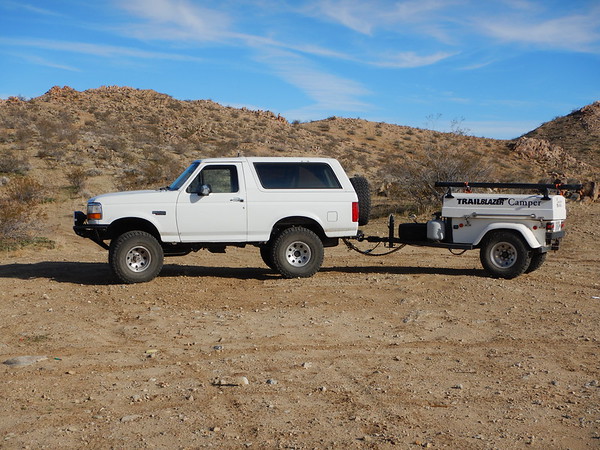ElPolloBlanco
SILVER Star
So I thought out a 3-axis coupler idea today, and wanted to run it by some other people before I committed to buying all the stuff for it. It goes like this from the truck to the trailer:
1. Clevis pin hitch in its standard orientation. This provides left and right movement.
2. A 5 inch long 2 inch .25 wall square tube with a .25 inch plate welded to one end. The plate has a hole with a 3/4 inch grade 8 bolt through it. Then a thrust bearing, then another square tube piece with a plate pinching the bearing together. This provides rotational movement. At the end of each tube are holes to allow a pin or bolt to be passed through to connect with clevis pin hitches.
3. Another clevis pin hitch , but turned 90 degrees. This allows for up and down movement.
I would probably use a bolt between 2 and 3 at the trailer side and a pin between 1 and 2 at the truck side.
I see this as somewhat similar to the Max Coupler design. Way cheaper than lock n roll or max coupler system. I plan on welding in a 2 inch receiver to the front of the trailer to fit either end of the setup through. I'd like to have y'all point out any potential flaws. I can't figure out the strength of the welds on the plates to the 2 inch tubes, but the bolt is something around 50,000 pounds in tensile and over 40,000 in shear, so I'm not worried about that pulling apart. I figure I can do this for under $100 as I already have the steel tube and plate. I'd just need the hitches at abut $40 each, bolt and hardware for less than $10, bearing is $5. With the plan to already have the 2 inch receiver on the trailer that cost doesn't factor in. If I decide to use a sealed thrust bearing, which I probably should, the price might get pushed over $100 a little.
So tear my plan apart. Better to do it here than have it tear itself apart doing 45 on a desert road.
1. Clevis pin hitch in its standard orientation. This provides left and right movement.
2. A 5 inch long 2 inch .25 wall square tube with a .25 inch plate welded to one end. The plate has a hole with a 3/4 inch grade 8 bolt through it. Then a thrust bearing, then another square tube piece with a plate pinching the bearing together. This provides rotational movement. At the end of each tube are holes to allow a pin or bolt to be passed through to connect with clevis pin hitches.
3. Another clevis pin hitch , but turned 90 degrees. This allows for up and down movement.
I would probably use a bolt between 2 and 3 at the trailer side and a pin between 1 and 2 at the truck side.
I see this as somewhat similar to the Max Coupler design. Way cheaper than lock n roll or max coupler system. I plan on welding in a 2 inch receiver to the front of the trailer to fit either end of the setup through. I'd like to have y'all point out any potential flaws. I can't figure out the strength of the welds on the plates to the 2 inch tubes, but the bolt is something around 50,000 pounds in tensile and over 40,000 in shear, so I'm not worried about that pulling apart. I figure I can do this for under $100 as I already have the steel tube and plate. I'd just need the hitches at abut $40 each, bolt and hardware for less than $10, bearing is $5. With the plan to already have the 2 inch receiver on the trailer that cost doesn't factor in. If I decide to use a sealed thrust bearing, which I probably should, the price might get pushed over $100 a little.
So tear my plan apart. Better to do it here than have it tear itself apart doing 45 on a desert road.


